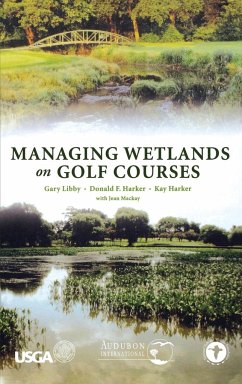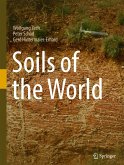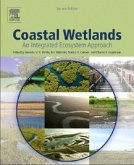Donald F. Harker
Managing Wetlands on Golf Courses
Donald F. Harker
Managing Wetlands on Golf Courses
- Gebundenes Buch
- Merkliste
- Auf die Merkliste
- Bewerten Bewerten
- Teilen
- Produkt teilen
- Produkterinnerung
- Produkterinnerung
The management of wetlands is often an area of uncertainty. This book instructs golf course superintendents on how to successfully manage different types of wetlands and also offers information on the fundamentals of conservation and restoration.
_ Covers general information about wetlands as well as the fundamental practices in restoration and conservation _ Discusses seven types of wetlands with regard to management _ Case studies provide a look at golf courses that currently manage wetlands successfully _ Includes over fifty photographs providing a rich visual resource _ Appendices…mehr
Andere Kunden interessierten sich auch für
![Wetlands in Central Europe Wetlands in Central Europe]() Gabriele Broll / Wolfgang Merbach / Eva-Maria Pfeiffer (eds.)Wetlands in Central Europe77,99 €
Gabriele Broll / Wolfgang Merbach / Eva-Maria Pfeiffer (eds.)Wetlands in Central Europe77,99 €![Die Entdeckung der Landschaft Die Entdeckung der Landschaft]() Hansjörg KüsterDie Entdeckung der Landschaft8,95 €
Hansjörg KüsterDie Entdeckung der Landschaft8,95 €![Böden der Welt Böden der Welt]() Wolfgang ZechBöden der Welt84,99 €
Wolfgang ZechBöden der Welt84,99 €![Soils of the World Soils of the World]() Wolfgang ZechSoils of the World123,99 €
Wolfgang ZechSoils of the World123,99 €![Was ist Natur wert? Gegenüberstellung des ökologischen und volkswirtschaftlichen Wertes der Region Neckar-Alb Was ist Natur wert? Gegenüberstellung des ökologischen und volkswirtschaftlichen Wertes der Region Neckar-Alb]() Daniel HäußlerWas ist Natur wert? Gegenüberstellung des ökologischen und volkswirtschaftlichen Wertes der Region Neckar-Alb42,95 €
Daniel HäußlerWas ist Natur wert? Gegenüberstellung des ökologischen und volkswirtschaftlichen Wertes der Region Neckar-Alb42,95 €![Taif. Entwicklung, Struktur und traditionelle Architektur einer arabischen Stadt im Umbruch Taif. Entwicklung, Struktur und traditionelle Architektur einer arabischen Stadt im Umbruch]() Heinz GaubeTaif. Entwicklung, Struktur und traditionelle Architektur einer arabischen Stadt im Umbruch43,99 €
Heinz GaubeTaif. Entwicklung, Struktur und traditionelle Architektur einer arabischen Stadt im Umbruch43,99 €![Coastal Wetlands Coastal Wetlands]() Coastal Wetlands137,99 €
Coastal Wetlands137,99 €-
-
-
The management of wetlands is often an area of uncertainty. This book instructs golf course superintendents on how to successfully manage different types of wetlands and also offers information on the fundamentals of conservation and restoration.
_ Covers general information about wetlands as well as the fundamental practices in restoration and conservation
_ Discusses seven types of wetlands with regard to management
_ Case studies provide a look at golf courses that currently manage wetlands successfully
_ Includes over fifty photographs providing a rich visual resource
_ Appendices provide contact and regulatory information about wetland management, creation and restoration
_ Covers general information about wetlands as well as the fundamental practices in restoration and conservation
_ Discusses seven types of wetlands with regard to management
_ Case studies provide a look at golf courses that currently manage wetlands successfully
_ Includes over fifty photographs providing a rich visual resource
_ Appendices provide contact and regulatory information about wetland management, creation and restoration
Produktdetails
- Produktdetails
- Verlag: Wiley & Sons
- 1. Auflage
- Seitenzahl: 210
- Erscheinungstermin: 1. September 2004
- Englisch
- Abmessung: 235mm x 157mm x 17mm
- Gewicht: 427g
- ISBN-13: 9780471472735
- ISBN-10: 0471472735
- Artikelnr.: 12962857
- Herstellerkennzeichnung
- Libri GmbH
- Europaallee 1
- 36244 Bad Hersfeld
- gpsr@libri.de
- Verlag: Wiley & Sons
- 1. Auflage
- Seitenzahl: 210
- Erscheinungstermin: 1. September 2004
- Englisch
- Abmessung: 235mm x 157mm x 17mm
- Gewicht: 427g
- ISBN-13: 9780471472735
- ISBN-10: 0471472735
- Artikelnr.: 12962857
- Herstellerkennzeichnung
- Libri GmbH
- Europaallee 1
- 36244 Bad Hersfeld
- gpsr@libri.de
GARY LIBBY is an ecologist with EcoTech, Inc., of Frankfort, Kentucky. DONALD F. HARKER is cofounder and President of Communities by Choice, in Bend, Oregon, an organization dedicated to advancing sustainable community development. KAY HARKER is manager of The Planning and Program Coordination branch of the Kentucky Department for Environmental Protection. JEAN MACKAY is director of educational programs at Audubon International, an environmental organization in Selkirk, New York.
Foreword.
Preface.
Acknowledgments.
CHAPTER 1: Introduction to Wetlands.
WHAT ARE WETLANDS?
WHY ARE WETLANDS IMPORTANT?
TYPES OF WETLANDS.
Estuaries.
Rivers, Streams, and Creeks.
Lakes and Ponds.
Marshes and Wet Meadows.
Forested Wetlands.
Shrub Wetlands.
Bogs.
CHAPTER 2: Conservation of Wetlands.
IDENTIFYING AND PROTECTING NATURAL WETLANDS.
Wetland Protection.
INCORPORATING WETLANDS INTO MANAGED AREAS.
Natural Landscaping.
IMPORTANCE OF VEGETATION ZONES.
TRANSITION TO THE TERRESTRIAL ENVIRONMENT.
CHAPTER 3: Restoring and Creating Wetlands.
WHAT IS WETLAND RESTORATION?
Hydrology.
Soils.
Vegetation.
Additional Suggestions.
SITE PREPARATION.
CHOOSING AND OBTAINING APPROPRIATE WETLAND PLANTS.
DESIGN CONSIDERATIONS.
ECOLOGICAL SUCCESSION.
CONTROLLING EXOTIC SPECIES.
WILDLIFE CONSIDERATIONS.
CHAPTER 4: Structure, Biology, Restoration, and Management of Wetlands by
Type.
ESTUARIES.
Physical Characteristics of Estuaries.
Plants and Animals of Estuaries.
Restoration and Management of Estuaries.
Key Species by Region.
RIVERS, STREAMS, AND CREEKS.
Physical Characteristics of Rivers, Streams, and Creeks.
Plants and Animals of Rivers, Streams, and Creeks.
Restoration and Management of Rivers, Streams, and Creeks.
Key Species by Region.
LAKES AND PONDS.
Physical Characteristics of Lakes and Ponds.
Plants and Animals of Lakes and Ponds.
Restoration and Management of Lakes and Ponds.
Key Species by Region.
MARSHES AND WET MEADOWS.
Physical Characteristics of Marshes and Wet Meadows.
Plants and Animals of Marshes and Wet Meadows.
Restoration and Management of Marshes and Wet Meadows.
Key Species by Region.
FORESTED WETLANDS.
Physical Characteristics of Forested Wetlands.
Plants and Animals of Forested Wetlands.
Restoration and Management of Forested Wetlands.
Key Species by Region.
SHRUB WETLANDS.
Physical Characteristics of Shrub Wetlands.
Plants and Animals of Shrub Wetlands.
Restoration and Management of Shrub Wetlands.
Key Species by Region.
BOGS.
Physical Characteristics of Bogs.
Plants and Animals of Bogs.
Restoration and Management of Bogs.
Key Species by Region.
CHAPTER 5: Golf Courses and Wetlands.
PAST AND PRESENT ROLES OF WETLANDS ON GOLF COURSES.
Opportunities for Integrating Wetlands on Golf Courses.
Wetlands on Existing Golf Courses.
New Golf Course Developments.
Golfer and Community Education.
Environmental Management Planning.
Self-Assessment Checklist for Managing Wetlands on Golf Courses.
APPENDIX A: Common and Scientific Names of Organisms.
APPENDIX B: Wetland Resources.
APPENDIX C: Wetland Regulatory Issues.
Glossary.
Bibliography and References.
About the Authors.
Index.
Preface.
Acknowledgments.
CHAPTER 1: Introduction to Wetlands.
WHAT ARE WETLANDS?
WHY ARE WETLANDS IMPORTANT?
TYPES OF WETLANDS.
Estuaries.
Rivers, Streams, and Creeks.
Lakes and Ponds.
Marshes and Wet Meadows.
Forested Wetlands.
Shrub Wetlands.
Bogs.
CHAPTER 2: Conservation of Wetlands.
IDENTIFYING AND PROTECTING NATURAL WETLANDS.
Wetland Protection.
INCORPORATING WETLANDS INTO MANAGED AREAS.
Natural Landscaping.
IMPORTANCE OF VEGETATION ZONES.
TRANSITION TO THE TERRESTRIAL ENVIRONMENT.
CHAPTER 3: Restoring and Creating Wetlands.
WHAT IS WETLAND RESTORATION?
Hydrology.
Soils.
Vegetation.
Additional Suggestions.
SITE PREPARATION.
CHOOSING AND OBTAINING APPROPRIATE WETLAND PLANTS.
DESIGN CONSIDERATIONS.
ECOLOGICAL SUCCESSION.
CONTROLLING EXOTIC SPECIES.
WILDLIFE CONSIDERATIONS.
CHAPTER 4: Structure, Biology, Restoration, and Management of Wetlands by
Type.
ESTUARIES.
Physical Characteristics of Estuaries.
Plants and Animals of Estuaries.
Restoration and Management of Estuaries.
Key Species by Region.
RIVERS, STREAMS, AND CREEKS.
Physical Characteristics of Rivers, Streams, and Creeks.
Plants and Animals of Rivers, Streams, and Creeks.
Restoration and Management of Rivers, Streams, and Creeks.
Key Species by Region.
LAKES AND PONDS.
Physical Characteristics of Lakes and Ponds.
Plants and Animals of Lakes and Ponds.
Restoration and Management of Lakes and Ponds.
Key Species by Region.
MARSHES AND WET MEADOWS.
Physical Characteristics of Marshes and Wet Meadows.
Plants and Animals of Marshes and Wet Meadows.
Restoration and Management of Marshes and Wet Meadows.
Key Species by Region.
FORESTED WETLANDS.
Physical Characteristics of Forested Wetlands.
Plants and Animals of Forested Wetlands.
Restoration and Management of Forested Wetlands.
Key Species by Region.
SHRUB WETLANDS.
Physical Characteristics of Shrub Wetlands.
Plants and Animals of Shrub Wetlands.
Restoration and Management of Shrub Wetlands.
Key Species by Region.
BOGS.
Physical Characteristics of Bogs.
Plants and Animals of Bogs.
Restoration and Management of Bogs.
Key Species by Region.
CHAPTER 5: Golf Courses and Wetlands.
PAST AND PRESENT ROLES OF WETLANDS ON GOLF COURSES.
Opportunities for Integrating Wetlands on Golf Courses.
Wetlands on Existing Golf Courses.
New Golf Course Developments.
Golfer and Community Education.
Environmental Management Planning.
Self-Assessment Checklist for Managing Wetlands on Golf Courses.
APPENDIX A: Common and Scientific Names of Organisms.
APPENDIX B: Wetland Resources.
APPENDIX C: Wetland Regulatory Issues.
Glossary.
Bibliography and References.
About the Authors.
Index.
Foreword.
Preface.
Acknowledgments.
CHAPTER 1: Introduction to Wetlands.
WHAT ARE WETLANDS?
WHY ARE WETLANDS IMPORTANT?
TYPES OF WETLANDS.
Estuaries.
Rivers, Streams, and Creeks.
Lakes and Ponds.
Marshes and Wet Meadows.
Forested Wetlands.
Shrub Wetlands.
Bogs.
CHAPTER 2: Conservation of Wetlands.
IDENTIFYING AND PROTECTING NATURAL WETLANDS.
Wetland Protection.
INCORPORATING WETLANDS INTO MANAGED AREAS.
Natural Landscaping.
IMPORTANCE OF VEGETATION ZONES.
TRANSITION TO THE TERRESTRIAL ENVIRONMENT.
CHAPTER 3: Restoring and Creating Wetlands.
WHAT IS WETLAND RESTORATION?
Hydrology.
Soils.
Vegetation.
Additional Suggestions.
SITE PREPARATION.
CHOOSING AND OBTAINING APPROPRIATE WETLAND PLANTS.
DESIGN CONSIDERATIONS.
ECOLOGICAL SUCCESSION.
CONTROLLING EXOTIC SPECIES.
WILDLIFE CONSIDERATIONS.
CHAPTER 4: Structure, Biology, Restoration, and Management of Wetlands by
Type.
ESTUARIES.
Physical Characteristics of Estuaries.
Plants and Animals of Estuaries.
Restoration and Management of Estuaries.
Key Species by Region.
RIVERS, STREAMS, AND CREEKS.
Physical Characteristics of Rivers, Streams, and Creeks.
Plants and Animals of Rivers, Streams, and Creeks.
Restoration and Management of Rivers, Streams, and Creeks.
Key Species by Region.
LAKES AND PONDS.
Physical Characteristics of Lakes and Ponds.
Plants and Animals of Lakes and Ponds.
Restoration and Management of Lakes and Ponds.
Key Species by Region.
MARSHES AND WET MEADOWS.
Physical Characteristics of Marshes and Wet Meadows.
Plants and Animals of Marshes and Wet Meadows.
Restoration and Management of Marshes and Wet Meadows.
Key Species by Region.
FORESTED WETLANDS.
Physical Characteristics of Forested Wetlands.
Plants and Animals of Forested Wetlands.
Restoration and Management of Forested Wetlands.
Key Species by Region.
SHRUB WETLANDS.
Physical Characteristics of Shrub Wetlands.
Plants and Animals of Shrub Wetlands.
Restoration and Management of Shrub Wetlands.
Key Species by Region.
BOGS.
Physical Characteristics of Bogs.
Plants and Animals of Bogs.
Restoration and Management of Bogs.
Key Species by Region.
CHAPTER 5: Golf Courses and Wetlands.
PAST AND PRESENT ROLES OF WETLANDS ON GOLF COURSES.
Opportunities for Integrating Wetlands on Golf Courses.
Wetlands on Existing Golf Courses.
New Golf Course Developments.
Golfer and Community Education.
Environmental Management Planning.
Self-Assessment Checklist for Managing Wetlands on Golf Courses.
APPENDIX A: Common and Scientific Names of Organisms.
APPENDIX B: Wetland Resources.
APPENDIX C: Wetland Regulatory Issues.
Glossary.
Bibliography and References.
About the Authors.
Index.
Preface.
Acknowledgments.
CHAPTER 1: Introduction to Wetlands.
WHAT ARE WETLANDS?
WHY ARE WETLANDS IMPORTANT?
TYPES OF WETLANDS.
Estuaries.
Rivers, Streams, and Creeks.
Lakes and Ponds.
Marshes and Wet Meadows.
Forested Wetlands.
Shrub Wetlands.
Bogs.
CHAPTER 2: Conservation of Wetlands.
IDENTIFYING AND PROTECTING NATURAL WETLANDS.
Wetland Protection.
INCORPORATING WETLANDS INTO MANAGED AREAS.
Natural Landscaping.
IMPORTANCE OF VEGETATION ZONES.
TRANSITION TO THE TERRESTRIAL ENVIRONMENT.
CHAPTER 3: Restoring and Creating Wetlands.
WHAT IS WETLAND RESTORATION?
Hydrology.
Soils.
Vegetation.
Additional Suggestions.
SITE PREPARATION.
CHOOSING AND OBTAINING APPROPRIATE WETLAND PLANTS.
DESIGN CONSIDERATIONS.
ECOLOGICAL SUCCESSION.
CONTROLLING EXOTIC SPECIES.
WILDLIFE CONSIDERATIONS.
CHAPTER 4: Structure, Biology, Restoration, and Management of Wetlands by
Type.
ESTUARIES.
Physical Characteristics of Estuaries.
Plants and Animals of Estuaries.
Restoration and Management of Estuaries.
Key Species by Region.
RIVERS, STREAMS, AND CREEKS.
Physical Characteristics of Rivers, Streams, and Creeks.
Plants and Animals of Rivers, Streams, and Creeks.
Restoration and Management of Rivers, Streams, and Creeks.
Key Species by Region.
LAKES AND PONDS.
Physical Characteristics of Lakes and Ponds.
Plants and Animals of Lakes and Ponds.
Restoration and Management of Lakes and Ponds.
Key Species by Region.
MARSHES AND WET MEADOWS.
Physical Characteristics of Marshes and Wet Meadows.
Plants and Animals of Marshes and Wet Meadows.
Restoration and Management of Marshes and Wet Meadows.
Key Species by Region.
FORESTED WETLANDS.
Physical Characteristics of Forested Wetlands.
Plants and Animals of Forested Wetlands.
Restoration and Management of Forested Wetlands.
Key Species by Region.
SHRUB WETLANDS.
Physical Characteristics of Shrub Wetlands.
Plants and Animals of Shrub Wetlands.
Restoration and Management of Shrub Wetlands.
Key Species by Region.
BOGS.
Physical Characteristics of Bogs.
Plants and Animals of Bogs.
Restoration and Management of Bogs.
Key Species by Region.
CHAPTER 5: Golf Courses and Wetlands.
PAST AND PRESENT ROLES OF WETLANDS ON GOLF COURSES.
Opportunities for Integrating Wetlands on Golf Courses.
Wetlands on Existing Golf Courses.
New Golf Course Developments.
Golfer and Community Education.
Environmental Management Planning.
Self-Assessment Checklist for Managing Wetlands on Golf Courses.
APPENDIX A: Common and Scientific Names of Organisms.
APPENDIX B: Wetland Resources.
APPENDIX C: Wetland Regulatory Issues.
Glossary.
Bibliography and References.
About the Authors.
Index.








